Create and manage dataset parameters (Deprecated)
Datasets are deprecated. Starting June 2, 2026, you will no longer be able to create datasets or edit existing datasets. Migrate your datasets to data models and update any documents that use datasets as a data source to use a different source. See Migrate a dataset to a data model.
A dataset parameter is a customizable field that you can add to a dataset worksheet and reference in formulas and in custom SQL. Creating dataset parameters and referencing them allows you to dynamically replace values used in calculations.
Use a parameter instead of a constant value for what-if and user input analysis. Using a parameter lets users change its value very quickly. For example, you might want to compare product sales growth by a variable 2%, 5%, and 10% percent. A parameter can quickly inject this variable value into a formula.
Dataset parameters can also improve performance for expensive workbook queries. Use dataset parameters to filter the data down to only what is needed.
If you want to use a parameter with a data model instead of a dataset, see Pass a value from a workbook control to a data model control.
User requirements
The ability to create, edit, delete, and use parameters in datasets requires the following:
- You must be assigned an account type with the Create, edit, and publish data models permission enabled.
- You must be the the dataset owner or be granted Can edit dataset permissions.
The ability to view parameters in a dataset, requires the following:
- You must be assigned an account type with the View data models permission enabled.
- You must be the the dataset owner or be granted Can view dataset permissions.
View dataset parameters in a dataset worksheet
From the Sigma Home page, select an existing dataset or create a new one. See Create Datasets.
When viewing a dataset, access dataset parameters when viewing the Worksheet tab for the dataset, in the left panel:
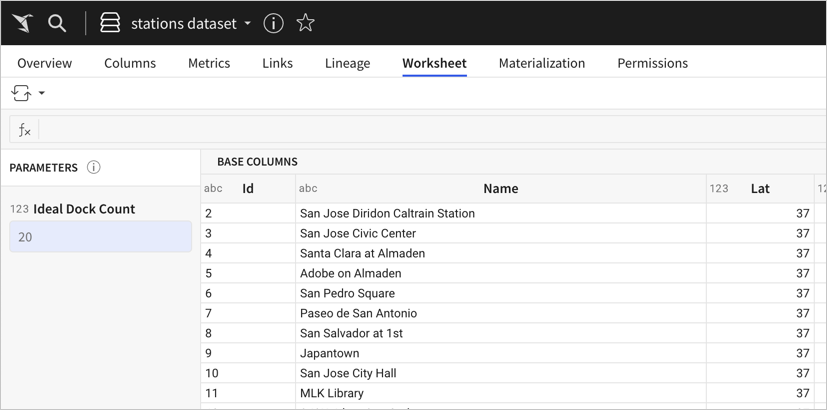
In the left panel, all existing dataset parameters are shown under Parameters. For each parameter, you can see:
- Data type: Represents the value type of the parameter, such as text (abc), number (123), or date (calendar). For more information see Supported data types and formats.
- Parameter name: The name of the parameter.
- Parameter value: The current value of the parameter. When editing the dataset, you can input a new parameter value. Depending on the parameter settings, you might choose a value from a list, input text, input a number, or select a date.
- Parameter menu: Menu to edit, duplicate, or delete the parameter. Select the
to open the menu. This menu is only available when editing the dataset.
Create a dataset parameter
-
Open a dataset, then open the Worksheet tab for the dataset.
-
Click Edit.
-
If the left control panel is not already open, expand it by clicking Show Controls in the toolbar, or by selecting the Controls bar.
-
In the Parameters section, click Add Parameter.
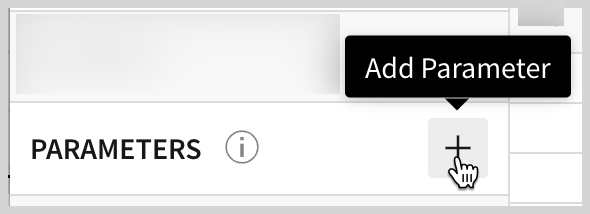
The Add Parameter modal opens.
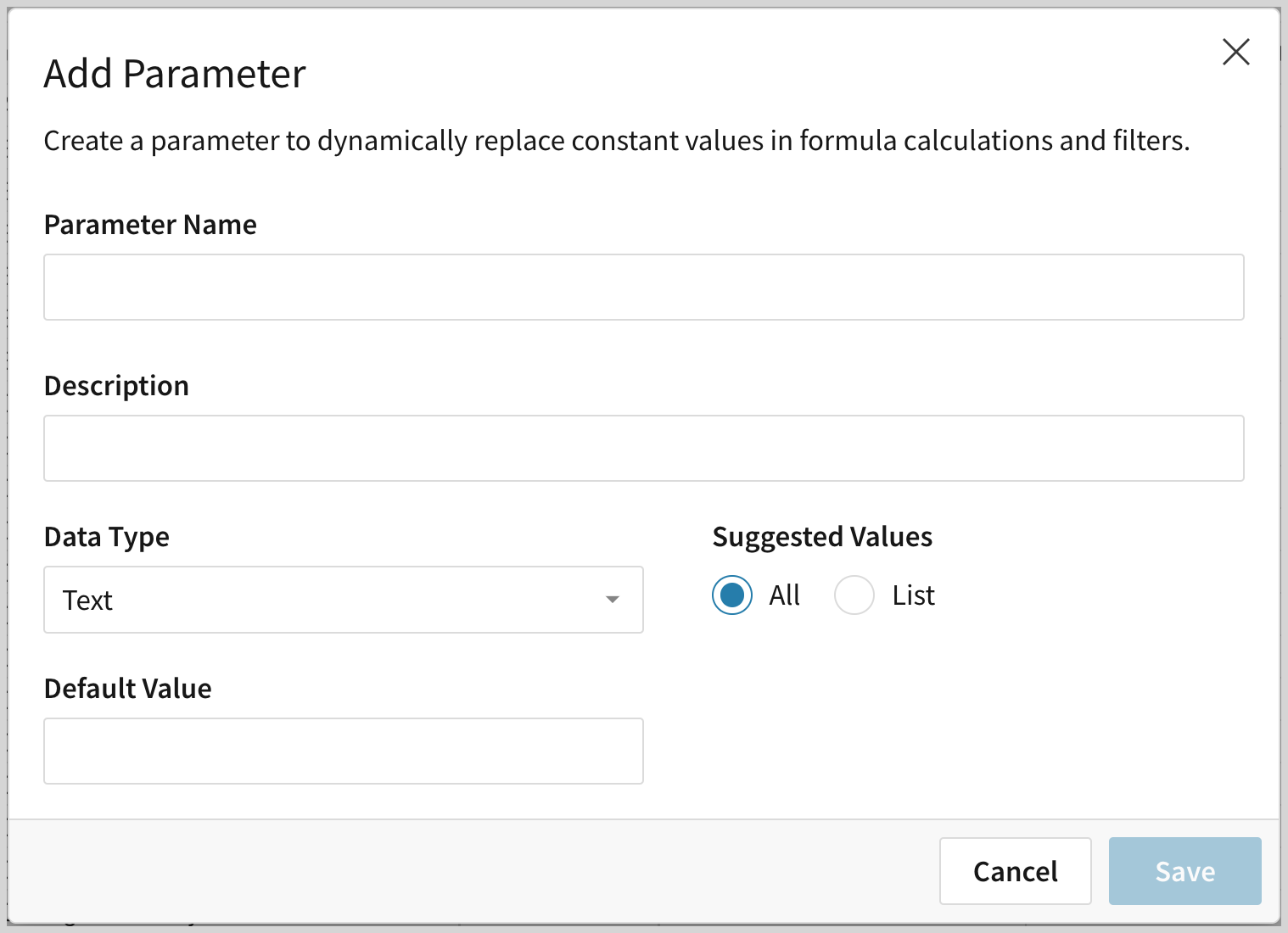
-
For Parameter Name, enter a name for the parameter.
-
(Optional) Add a description.
-
Select the Data Type (Text, Number, or Date) for the parameter.
-
The Suggested Values option determines the parameter’s input type. Select either:
- All: Depending on the data type, can be a text, number, or date value.
- List: A custom set of value options. Users can select any value in the list. See Use a list of values in a dataset parameter.
-
(Optional) Specify a Default Value for the parameter.
-
(Optional) For date or number data types, specify a Format for the parameter value.
-
Click Save.
After creating a parameter, you can use it in one of the following ways:
- In the dataset worksheet left Controls panel, change the value.
- Reference the parameter in a formula, such as in a new dataset column. See Reference a dataset parameter in a formula in a dataset worksheet.
- Update the value of the parameter based on the selection in a workbook control. See Parameters in Workbooks.
Use a list of values in a dataset parameter
-
Follow the steps to create a dataset parameter, then for Suggested Values, select List.
-
(Optional) For a date or number data type, specify a Format for the parameter value. For example, format a Number value as currency.
-
In the Values List, add each value. If you defined a display format, the Display Value reflects the formatting.
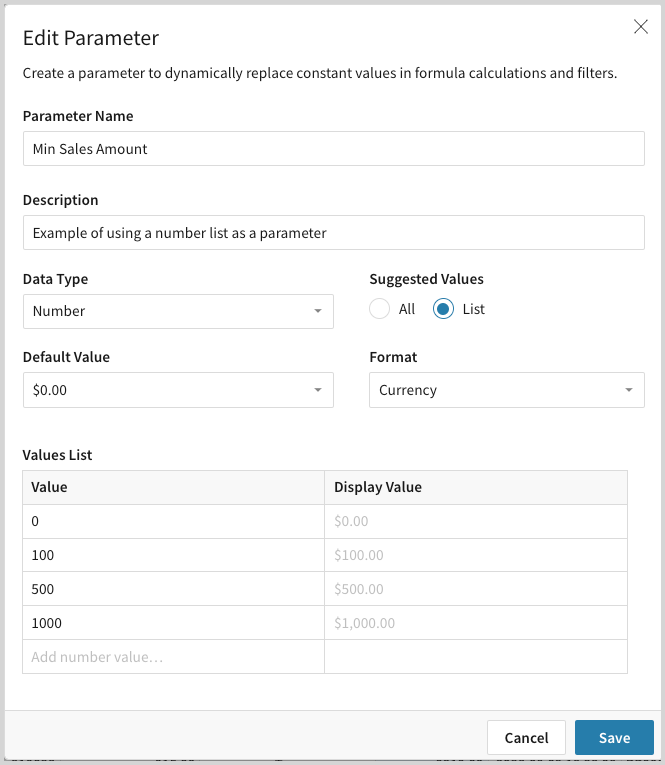
-
(Optional) In the Default Value dropdown menu, select one of the values from the list.
-
Click Save.
Reference a dataset parameter in a formula in a dataset worksheet
You can reference a dataset parameter by name in a worksheet column formula. The formula uses the value of the parameter and automatically updates when the parameter value is changed.
For example, for a dataset with a Revenue column, you might create a Min Sales Amount parameter, then calculate a formula to evaluate whether the sales revenue is greater than the minimum sales amount:
-
Add a new column to the dataset.
-
In the formula bar for the new column, enter the name of the dataset parameter surrounded by square brackets. For example,
[Min Sales Amount].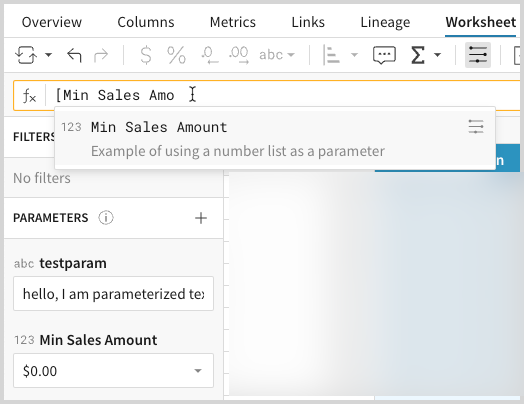
-
Rename the column to reflect the formula. For example, Min Sales Param.
-
In the parameter list, update the value of the parameter and observe the changes to the column.
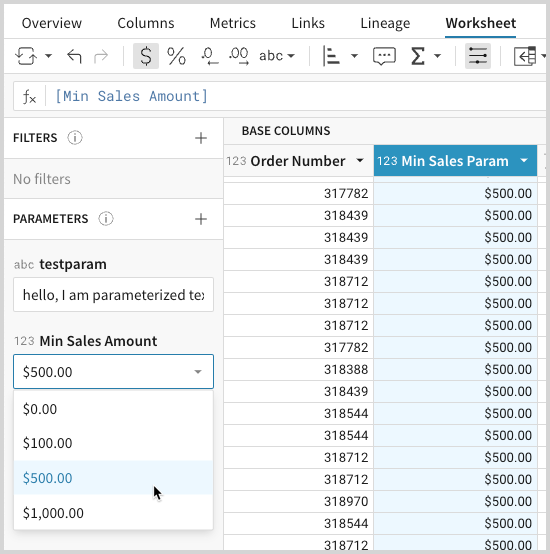
-
Modify the column formula to use the parameter in a calculation. For example, evaluate whether the Revenue for each row in the column is greater than the Min Sales Amount parameter value using the formula:
[Revenue] > [Min Sales Amount]Sigma automatically calculates a Boolean (logical) value for the column.
-
In the parameter list, change the value of the parameter and observe the changes to the true/false values in the column.
The calculated column automatically updates when you enter a new parameter value.
Filter a dataset worksheet with a dataset parameter
To filter a dataset worksheet based on a dataset parameter:
-
Create a parameter. See Create a dataset parameter.
-
Reference the parameter in a column formula. See Reference a dataset parameter in a formula in a dataset worksheet.
-
Create a filter for that column:
-
From the column menu, select Add Filter.
-
In the Add Filter modal, select the filter type and the filter value(s) to filter in the dataset. For example, choose to display only True values.
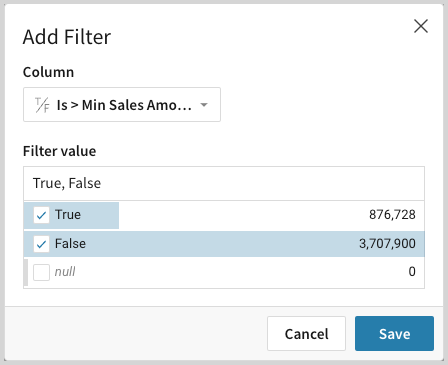
-
Click Save.
The filter appears in the side panel in the Filters section. You can update the parameter and the filter from the panel.
-
Reference a dataset parameter in SQL
You can create a dataset or populate a workbook element by writing a SQL query against a connected data platform. You can use dataset parameters in your SQL query by wrapping the name of the parameter in curly brackets:
{{<dataset-parameter-name>}}
After you update a SQL statement to reference a parameter, changes to the parameter value propagate to the SQL source and refresh the data.
To reference a dataset parameter in SQL:
-
In a workbook, create a data element from SQL. See Create a data element.
-
When writing the SQL, add the parameter by referencing its name in double curly brackets, replacing any spaces in the name with hyphens:
{{<parameter-name>}}For example:
select * from EXAMPLES.PLUGS_ELECTRONICS.F_POINT_OF_SALE where SALES_AMOUNT > {{min-sales-amount)} -
If the parameter value is passed into the SQL with single quotation marks, you can remove these quotation marks by prepending the special keyword "#raw" before the parameter name:
{{#raw <parameter name>}}
If you use the
#rawconfiguration value, row-level security can be bypassed, creating a security vulnerability. -
-
After saving the SQL, test the results by inputting a value in the parameter and review the output of the data element.
For more examples and details, see Write custom SQL and Create a dataset from SQL.
Delete a dataset parameter
To permanently delete a dataset parameter:
- Go to a dataset's worksheet tab.
- Click Edit.
- If the left control panel is not already open, expand it by clicking Show Controls in the toolbar, or by selecting the Controls bar.
- In the Parameters list, hover over the parameter that you want to delete, then click the caret to open the dropdown menu.
- Click Delete.
Updated 14 days ago
